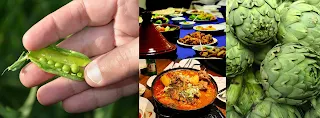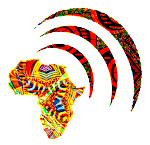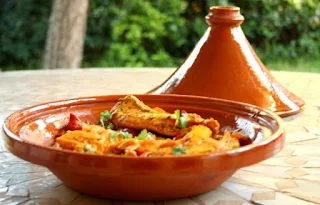Algerian Jelbana Artichokes and Green Peas Tajine Recipe
Algerian jelbana stew tajine with artichokes and green peas is a classic African Algerian stew recipe. Traditional Algerian jelbana is slow cooked in a tajine, but you can make this North African recipe using your stew pot.
Learn to make Algerian Jelbana Artichokes and Green Peas Tajine Recipe and discover facts about Africa's largest country Algeria.
Algerian Jelbana Artichokes and Green Peas Tajine Recipe
Ingredients
4 skinless chicken thighs
2 cups frozen green peas
1 small can artichoke hearts
1 large yellow onion, chopped
2 medium tomatoes, diced
2 medium white potatoes, diced
1 cup frozen baby carrots
2 tablespoons chopped parsley
2 whole bay leaves
½ teaspoon salt
½ teaspoon pepper
1 teaspoon paprika
1 teaspoon ground coriander
2 minced garlic cloves 2 cups water
Directions
Mix spices into a small bowl then add all ingredients into a large lidded stew pot. Simmer 30 minutes until vegetables are tender. Serve with homemade bread.

|
| Classic African Algerian stew recipe |
About Algeria location and climate
Algeria is mostly high plateau and desert located in Northern Africa, bordering the Mediterranean Sea, situated between Morocco and Tunisia and is slightly less than 3.5 times the size the US state of Texas. The climate is arid to semiarid; mild, wet winters with hot, dry summers along coast; drier with cold winters and hot summers on high plateau. Algeria’s mountainous areas subject to severe earthquakes; mudslides and floods in rainy season; drought; it is the largest country in Africa but 80% desert. Canyons and caves are located in the southern Hoggar Mountains and in the barren Tassili n'Ajjer area in the southeast of the country contains numerous examples of prehistoric art - rock paintings and carvings depicting human activities and wild and domestic animals that date to the African Humid Period, roughly 11,000 to 5,000 years ago, when the region was completely vegetated.
On the people of Algeria
The massive majority of the population in Algeria is found in the extreme northern part of the country along the Mediterranean Coast with Arab-Berber 99% and European less than 1% ethnic groups. The population is around 45 million Muslims with languages spoken Arabic (official), French (lingua franca), Berber or Tamazight (official); dialects include Kabyle Berber (Taqbaylit), Shawiya Berber (Tacawit), Mzab Berber, Tuareg Berber (Tamahaq). Major urban areas are 2.694 million living in the capital of Algiers and 881,000 living in the city of Oran.
A brief note regarding the Algerian economy
Hydrocarbons have long been the backbone of the Algerian economy, accounting for roughly 30% of GDP, 60% of budget revenues, and nearly 95% of export earnings. Algeria has the 10th-largest reserves of natural gas in the world - including the 3rd-largest reserves of shale gas - and is the 6th-largest gas exporter. It ranks 16th in proven oil reserves. The main export partners are Italy 17.4%, Spain 13%, France 11.9%, US 9.4%, Brazil 6.2%, and the Netherlands 5.5%.
More economical easy lunch and dinner recipes to make right now so you never have to eat or prepare a boring meal again.
- Curried Tanzanian Coconut Okra Recipe
- Frikkadelle an Afrikaner dish of meatballs
- Senegalese Chicken Vermicelli
- Chadian Steamed Honey Cassava Buns
- Cameroon Smoked Bonga Fish Stew

 Since 2007
Since 2007



